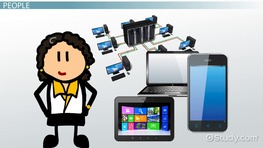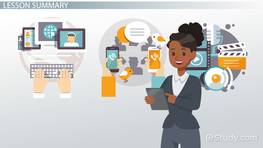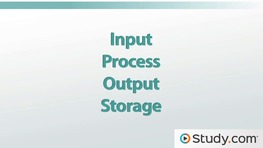Explore Information Technology
Information Technology Courses
Study.com has computer science and IT courses available to students at every level of learning, from elementary school to college.
Explore our full library of information technology courses:
Computer Science 102: Fundamentals of Information Technology
Computer Science 103: Computer Concepts & Applications
Computer Science 310: Current Trends in Computer Science & IT
Business 104: Information Systems and Computer Applications
Business 109: Intro to Computing
Explore our full library of information technology courses:
What is Information Technology?
Information technology is defined as any given technology or device that is used to store, create, manipulate, distribute, or otherwise disperse information of any kind. Commonly abbreviated as IT, information technology involves a combination of tele-communications and computing technologies, by which high-speed links deliver text, audio, or visual information from one person to another. Computers are multifunctional, programmable machines that increase human productivity and problem solving efficiency. Communication technology comes in many forms of electromagnetic devices used to transmit information at a distance. As such, examples of information technology that we use in our everyday lives include smartphones, text messaging, email, social media, telemedicine and other video calling services, databases of various kinds, all of which rely on a computer to some degree, as well as, more generally, the internet itself.
Computers are, therefore, the basis of all information technology. In the simplest terms, computers exist to turn data, raw figures and facts, into information that can be used for decision making purposes. Generally this happens through a process involving the four basic operations of a computer: input, processing, storage, and output. To understand these, consider how one creates a table in Excel. One inputs raw data, numbers perhaps, into a spreadsheet. One then organizes those numbers into a table that expresses deeper information, using labels and columns. One then saves that table on the computer, so it is not lost, and finally one has the computer output that information, perhaps by printing the table, or attaching it to a Word document or pdf. At this point, almost every computer also has a fifth basic operation: communication. To round out the Excel table example, the computer would be performing the communication operation by sending the finished table to another computer via email or a social media post by way of the internet.
These operations are performed as a product of a complex interconnection of hardware, software, various networks, and the internet. Maintaining and managing these tangled webs of physical devices, raw data, software applications, processed and stored information, networks of various sizes and security levels, and internet usages and privacy is the task of the IT specialist. Their practical work done on a daily basis pushes the field of computer science forward, causing new technological innovations, and making the relationship between humans and computers ever more productive and efficient.




